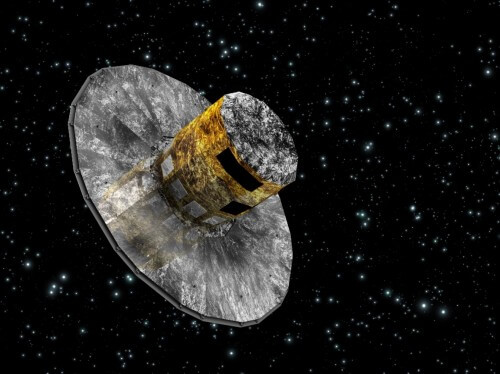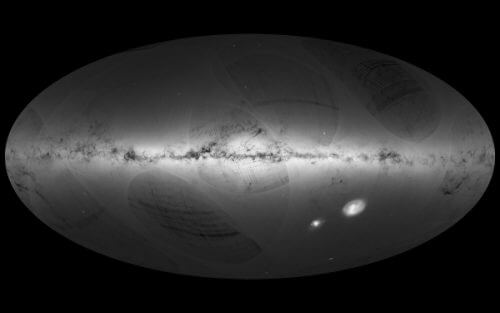This is what Prof. Zvi Maza from Tel Aviv University says ahead of the massive release of data collected by the Gaia spacecraft, which measures the exact location of stars in the milky way. Analyzing the spacecraft data * "Prof. Zucker: Gaia will help planetary researchers to more accurately characterize the stars they orbit"

"Gaia's data could enable breakthroughs in astronomy". This is what Prof. Zvi Maza from Tel Aviv University says ahead of the massive release of data collected by the European Space Agency's Gaia spacecraft that measures the exact location of stars in the Milky Way. The research groups of Prof. Shai Zucker from the Department of Geophysics and Prof. Zvi Maza from the Department of Astrophysics at Tel University -Aviv members of the DPAC team that analyzes the spacecraft data. The two were interviewed by the Hedaan site ahead of the event.
Astronomers all over the world are excitedly waiting for the publication of the measurement database of the Gaia spacecraft, which is supposed to be released today (Wednesday, April 25, 2018). The Gaia spacecraft was launched on December 19, 2013, and since then it has been recording the position, distance, motion, brightness and temperature of over a billion stars. Gaia's "camera" has more than a billion pixels, and it allows for amazing precision: Gaia measures the position of a star in the galaxy with an accuracy of 10 microseconds of arc - such accuracy is equivalent to determining the position of a grain of sand on the moon with an accuracy of a millimeter, using an observation from Earth . The spacecraft, whose total cost is estimated at more than 2 billion euros, was built by the European Space Agency (ESA).
The spacecraft carries a telescope and instruments that make it possible to map with unprecedented precision more than a billion stars, and to obtain a XNUMXD map of our galaxy - the Milky Way galaxy containing about one hundred billion suns (stars). The precise XNUMXD map of the galaxy to be released on Wednesday will revolutionize galactic astronomy and help humanity finally understand how the Milky Way galaxy was formed, and even predict its future in the next billion years. The data will also make it possible to check whether the billions of stars in the galaxy are held together by the dark matter whose nature we still do not know. As part of their activities at DPAC, Prof. Zucker and Prof. Maza apply methods they developed to detect planets and black holes, by detecting and characterizing cyclical changes in the brightness of stars in the galaxy.
Waiting for Gaia - a video by the European Space Agency
We can get a real picture of the movement of stars within the galaxy
In a conversation with the science website, Prof. Mazzeh explains: Gaia's policy is that they store, process and release everything at once at points in time. The processing of the last 22 months they are releasing today to thousands of scientists dealing with various aspects of astronomy within the Milky Way.
"This is a fantastic spacecraft that measures the position of the stars with great precision and it does it for 1.3 billion stars. Because of the accuracy it was possible to measure the distance to these stars and their movements. Suddenly we can get kinematics of the galaxy - its movement. The data is released to the scientific community. Many scientists, including myself, have already prepared plans to search the mountains of data - each according to their field of expertise."
"From the previous release, which was small compared to the current one, there are already 300 articles, this time I expect thousands of articles, every scientist who is interested in these nearby stars and the structure of our galaxy, as well as black holes, planets and even exotic phenomena. I estimate that this data will have a major impact on the science of astronomy. This is a leap forward in measuring the distance and movements of stars in the galaxy. No longer a little here a little there, this is something that will completely change knowledge."
what are you researching
"Now I am researching several fields, including the search for black holes. Even if we discover them in the current data we will have to continue to investigate the candidates we find.
In another area, we will be able to know whether our galaxy was formed from a collision between two large galaxies in the distant past - once we see how the stars move and are arranged, there will be evidence here or there."
The interesting things will be the unexpected. We'll start working with the data and we'll see things we didn't expect, like what happened when Galileo Galilei pointed the telescope to the sky, he saw things he didn't think existed."
"In general, it seems that astronomy is going through a wonderful process of breakthroughs in all kinds of fields. We started scratching the universe. Who expected in the past discoveries like dark matter, dark energy. I'm old enough to remember the first discovery of a neutron star in 1967 and the supermassive black holes at the core of every galaxy, not to mention the discovery of the acceleration of the universe's expansion at the end of the millennium and gravitational waves in recent years. "
Are discoveries made possible because of technological development or because of new ideas?
"In my opinion, it is a combination of technology with ideas that the theorists come up with. As an observer, I think it is mainly because of the technology, but it could not have happened without ideas on the basis of which new observation tools are built.

Prof. Shai Zucker shows greater caution in regards to expectations and estimates that in today's update no craters or black holes will be discovered because these two phenomena require the analysis of more measurements than have been accumulated so far.
I'm looking for planets transiting in front of their star. Although Gaia was not built specifically to look for planets, it is nevertheless estimated that with such a huge amount of data candidates for planets will also be discovered.
One of the services that Gaia provides in relation to the planets is the ability it allows to get a more accurate characterization of the stars. The photometric measurements make it possible to discover the size of the star and its temperature. When you discover a planet moving around a star, you need to know the solar characteristics of the system and therefore Gaia will provide unprecedented assistance to the field of planetary research. I believe that the measurements that will accumulate until the next release in 2020 will make it possible to discover planets as well.
"Unlike the missions designed to search for planets, Gaia does not sample the orbits at a high rate but every few weeks, and then it is a matter of luck if the planet just passed in front of its star. However, unlike the recently launched TESS satellite, which will observe bright stars, Gaia also observes fainter stars. I estimate that when we have the data of Gaia, TESS as well as those collected by Kepler and those collected by the European satellite Planet. The fusion of the data will give another possibility for the discovery of planets."

One response
At the time, I asked Professor Shai Zucker to check with the help of Gaia the movement of the double-double in the harp group known as Epsilon Lyra (ADS11635). The analysis of the movement of the two pairs can prove or "God forbid" disprove Newton's gravitation formula and/or Kepler's laws. At a distance of about ten thousand Astronomical units (about one sixth light year). which is much more than anything measured in the solar system. I wonder if it was done?
For those interested - article 73 on my blog
Good night
Sabdarmish Yehuda
http://yekumpashut.freevar.com/